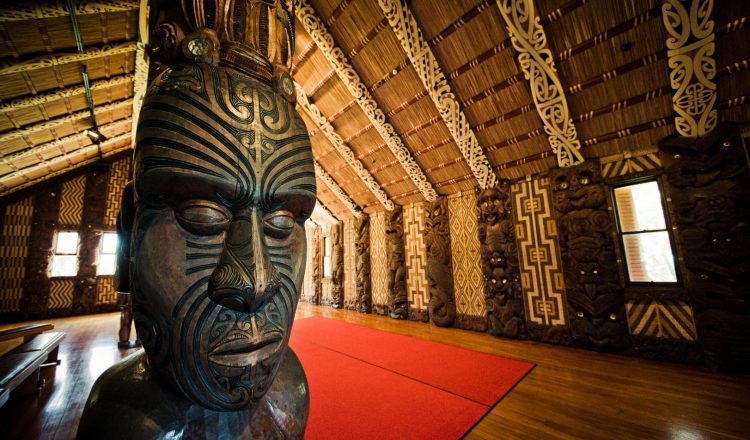마오리 예술
예술과 창조성이 신의 매개체라는 믿음을 깊이 가진 마오리 예술과 공예는 그들 문화의 성스러운 부분이며 전 세계적으로 인정받고 있는 몇 안 되는 마오리 생활의 한 단면입니다. 마오리족은 과거가 미래이며 현재가 그 둘을 잇는 루프(Loop) 믿습니다. 이러한 이유로 많은 전통 미술들은 가능한 조상들의 기법에 가장 가깝게 구현하려고 노력합니다. 예술의 신성함은 창조물에만 있는 것이 아니라 세대를 거쳐 전해오는 것에 있기 때문입니다.
포우나무(Pounamu)
포우나무(Pounamu) 또는 그린스톤(Greenstone)으로 불리는 이것은 단단한 돌이며 마오리 문화에서 소중히 다뤄집니다. 전통적으로 그린스톤은 연옥비취, 보웬광 또는 사문석으로 보여지며, 이 중 연옥(비취)가 오늘날 가장 흔한 형태의 암석입니다. 마오리에서는 포우나무가 신성한 마오리 보물인 타온가(taonga)라고 여겨집니다. 이로 인해 그린스톤을 발견 할 수있는 지역은 일반적으로 정부 법률에 의해 보호되며 지역 이위가 관리합니다.
마오리는 생활도구 및 장신구에 pounamu를 사용합니다. 도구가 너무 낡아서 사용할 수 없게 되면 보석으로 탈바꿈 시킵니다. 마오리 사회에서 그린스톤으로 만든 작품을 가짐으로써 자신의 위신을 높이기도 하지만, 이를 구입하거나 조각하는 것은 불운을 불러올 수 있습니다. 그린스톤 목걸이와 장신구는 세계적인 사랑을 받고 있으며 디즈니는 그들의 영화 모아나에서 그린스톤의 중요성을 언급했습니다.
화카이로(Whakairo)
화카이로(Whakairo)라고 불리는 조각품은 아직도 마오리 사람들에게 일상적이고 필수적입니다. 그린스톤과 마찬가지로 전통적으로 나무, 돌, 뼈는 조각을 위해 사용됩니다. 조각 스타일은 이위마다 다르지만, 화카이로는 자연과 한번 사용됐던 재료까지 다양합니니다. 목재는 전통적으로 와카(Waka, 카누)를 만들기 위해 현지에서 조달된 목재를 사용하기 때문에 가장 일반적인 마오리 조각 재료입니다. 나무 조각은 마라에(Marae, 집합 장소)를 장식하는 데 사용하기 때문에 현대 마오리 문화에서 중요한 부분입니다. 뼈조각은 주로 고래뼈를 사용하며 낚시바늘, 장신구와 같은 복잡한 도구를 만드는 데 사용합니다.
마오리 조각은 보통 인간의 몸을 수호하는 새의 머리를 가진 뱀, 마나이아(Manaia)를 묘사합니다. 화카이로의 예술은 심오한 영적 의미를 담고 있으며 그 정신은 오늘날까지 전해오고 있습니다.
라랑가(Raranga)
마오리 직조품 라랑가(Raranga)는 단순히 의류를 만드는 것 이상의 의미가 있습니다. 이는 예술가를 통해 신의 메시지를 전하는 관습입니다. 세대에 걸쳐 전해져 온 신성한 예술이며, 라랑가는 뉴질랜드에서 개인적으로 또는 대학에서도 배울 수 있습니다.
아마(Flax)는 아름다우면서도 복잡한 무늬의 옷, 바구니, 벽걸이 등을 만들기 위한 재료입니다. 마오리인들은 예식 때 전통적인 직조법으로 만든 옷을 입습니다. 마오리 공연자들은 자신들의 품격과 자랑스러운 유산을 보여주기 위해 이러한 옷을 입기도 합니다. 마오리 스타일의 직조는 보통 검은색, 흰색, 금색과 같이 자연에서 나온 색을 사용하지만, 현대에는 더 좋은 재품을 선보이기 위해 염색을 하기도 합니다.
타 모코(Ta Moko)
타 모코(Ta Moko)를 마오리 문신 예술이라고만 표현하기엔 충분치 않습니다. 타 모코는 단순한 문신을 넘는 매우 특별한 관습이기 때문입니다. 마오리 문신은 다른 폴리네시아 부족의 문양과 유사하지만 아름다움만을 목적으로 하지 않습니다. 얼굴과 몸에 있는 문신들은 시각적인 언어를 구사하며 사람, 부족, 역사, 사회적 지위에 대한 정보를 알려줍니다. 이 부족의 메시지는 문화적 자부심이 포함되며 마오리인들의 온정신을 보여줍니다. 남성과 여성 모두 문신을 할 수 있으며, 특히 마오리 문화에서 머리가 신성시되기 때문에 얼굴 문신은 최고의 명예를 보여줍니다. 얼굴 문신은 표정을 강조하기 때문에 이를 처음 본 사람들에겐 약간 위협적으로 보이기도 합니다. 하지만 타 모코는 사람들의 정체성을 보여줄 뿐만 아니라 문신이 전달하는 뜻에 따라 살아가기 위해 마오리인 일상의 변화까지 관장하는 것이므로 너무 낯설게 여길 필요는 없습니다.

















































